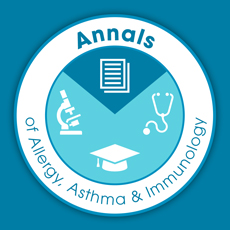 The last few months have been rough for all of us with the COVID-19 pandemic and the challenges it has presented to us, for personal and family safety as well as adverse impact on our patients and our practices. Yet we still need to learn new and important things that will allow us to deepen our knowledge and better care for our patients. The May issue of Annals is focused on food allergy, and there are many different articles that will interest and inform you. I wish to call your attention to several of them.
The last few months have been rough for all of us with the COVID-19 pandemic and the challenges it has presented to us, for personal and family safety as well as adverse impact on our patients and our practices. Yet we still need to learn new and important things that will allow us to deepen our knowledge and better care for our patients. The May issue of Annals is focused on food allergy, and there are many different articles that will interest and inform you. I wish to call your attention to several of them.
First is a review article by Vicki L. McWilliam, MND, PhD and colleagues who provide an excellent overview of the natural history of tree nut allergy. Tree nuts are common causes of food-related allergic reactions and anaphylaxis. Clinical resolution of tree nut allergy is thought to be low, yet studies of the natural history of tree nut allergy are limited. This review summarizes the available literature regarding tree nut allergy prevalence and natural history and discusses emerging diagnostic and prognostic developments that can inform clinical management.
This month's CME review article by John Andrew Bird, MD and Julia E.M. Upton, MD, MPH describes factors to be considered when contemplating oral food challenges used for the definitive diagnosis of food allergy. Risk and benefit assessment guide the oral food challenge procedure. The conduct of oral food challenges is influenced by multiple factors including age, the specific food to be tested, and the goal of the challenge. This article reinforces special considerations when offering and conducting oral food challenges.
Another feature that we showcase in Annals is our Perspectives. These are short, impactful pieces that provide an evidence-based opinion from the authors on topics of interest and importance to all of us. In particular, I would call your attention to the perspective on fatal food anaphylaxis by Stacy Dorris, MD. The development of a new online national database on food anaphylaxis deaths is presented and its value discussed. I encourage you to read it carefully and to participate if, God forbid, you have had patients in this category.
I hope you have some time to peruse your May edition of the Annals of Allergy, Asthma and Immunology. We want to be supportive in any way possible as we band together to come back from the effects of this pandemic. Let's keep looking out for one another and our collective patient population – it's what we do best!
Gailen D. Marshall, Jr., MD PhD, FACAAI
Editor-in-chief

